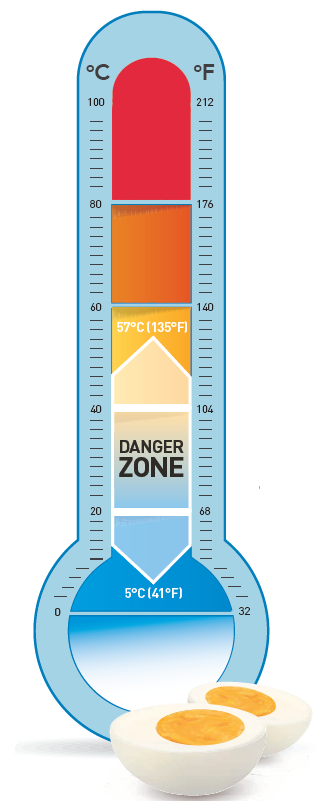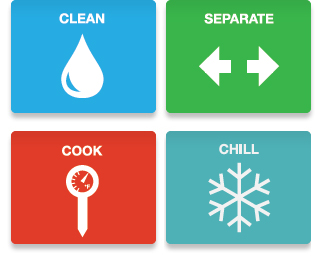Why Can Shell Eggs Be Received at an Air Temperature of 45ã‚â°f Instead of 41
Assuring the Safety of Eggs and Carte and Cafeteria Items Made From Raw, Shell Eggs
Data for Retail Nutrient Stores and Food Service Operations
Download (PDF: 28KB)
Fresh eggs may contain bacteria called Salmonella Enteritidis (SE) that can cause intestinal infections. Most healthy people recover from these infections within 4-7 days, but they can lead to astringent and fifty-fifty fatal illness, especially for those almost vulnerable to foodborne disease — young children, the elderly, or persons who live in a facility that provides custodial care, and persons with immune systems weakened past health problems. Illness from eggs — or foods that comprise them — tin can be prevented by proper preparation procedures and cooking to safe temperatures.
Receiving Eggs and Egg Products
- Shell eggs should be make clean and sound.
- Raw eggs must exist received in refrigerated equipment that maintains an ambient air temperature of seven°C (45°F) or less.
- Raw shell eggs that have not been specifically treated to destroy all viable Salmonella must be refrigerated at an ambient air temperature of 7°C (45°F) or below while stored and displayed.
- The label of all packages of raw shell eggs that have not been specifically treated to destroy all viable Salmonella must comport this safe handling statement—
SAFE Treatment INSTRUCTIONS:
TO Forbid ILLNESS FROM Bacteria:
KEEP EGGS REFRIGERATED, Cook EGGS UNTIL YOLKS ARE FIRM, AND COOK FOODS CONTAINING EGGS THOROUGHLY. - Take liquid, frozen and dried eggs and egg products only if pasteurized.
Preventing Contamination
- Launder hands with warm, soapy water before and after they come in contact with eggs and egg containing foods. Use clean utensils or unmarried-utilize gloves to handle fix-to-eat egg foods.
- Wash, rinse and sanitize utensils, equipment and work surfaces after preparing eggs or egg-containing foods.
- Keep cooked ready-to-swallow eggs and egg-containing foods separate from raw animal derived foods during storage, grooming, holding or display.
- Substitute pasteurized eggs or egg products for raw crush eggs in preparing such foods equally Caesar salad, hollandaise or béarnaise sauce, mayonnaise, eggnog, ice cream, and egg-fortified beverages that are not thoroughly cooked.
Cooking and Serving
- Cook raw shell eggs that are broken for firsthand training and service to heat all parts of the food to a temperature of 63°C (145°F) or above for xv seconds.
- Melt foods prepared with raw trounce eggs that are non broken for firsthand training and service to estrus all parts of the nutrient to a temperature of 68°C (155°F) for 17 seconds.
- Eggs and egg-containing foods cooked in a microwave oven should be: covered to retain surface moisture; rotated or stirred throughout or midway through cooking to promote even heat distribution; heated to a temperature of at least 74°C (165°F) in all parts of the food, and allowed to stand covered for two minutes before service.
Cooling
- Once cooked, eggs and egg-containing foods should be served immediately or cooled from 57°C (135°F) to 21°C (seventy°F) inside 2 hours and from 21°C (lxx°F) to 5°C (41°F) or less within an
additional iv hours.
Hot or Cold Holding
- If cooked eggs and egg-containing foods are held in hot holding equipment they should be held at a temperature of 57°C (135°F) or above.
- For common cold property, maintain cooked eggs and egg containing foods at 5°C (41°F) or below.
Added Safeguards for Highly Susceptible Populations
- Establishments that serve highly susceptible populations (young children, elderly persons, or persons who alive in a facility that provides custodial care and individuals with
weakened immune systems), such equally schools, day care centers, nursing homes and hospitals, should accept the following additional precautions. Due to factors such as age, medications,
compromised or immature immune systems, and various health weather condition, these populations are especially vulnerable to foodborne disease. - In NO case should soft-cooked eggs, that are made from raw eggs, soufflés or meringues or other foods that contain raw or undercooked eggs exist served in these facilities.
- As a general rule, pasteurized eggs or egg products should exist used in any recipe that calls for combining more than one egg ("pooling") and for whatever recipe, grooming or serving
procedure that involves holding eggs or egg-containing foods earlier or after cooking. - To add together an actress margin of safety, in improver to all of the above precautions, buyers can specify that suppliers provide eggs produced merely from flocks managed nether an SE control
program that is recognized past a regulatory agency that has animate being health jurisdiction.
Consumer Informational
Consumers should be informed past manner of a disclosure and reminder of the significantly increased health risk —especially to immature children, elderly, or persons who live in a facility that provides custodial care, and individuals with weakened immune systems —when eggs are eaten in a raw or undercooked form. Foods such equally scrambled or fried eggs, French toast and omelets are frequently undercooked, while other foods, such equally hollandaise or béarnaise sauce, mayonnaise, and chocolate mousse, may contain raw or under-cooked eggs. Consumers can be so informed by brochures, advisories on signs or menus, table tents, placards, labeling or other effective written ways.


0 Response to "Why Can Shell Eggs Be Received at an Air Temperature of 45ã‚â°f Instead of 41"
Post a Comment